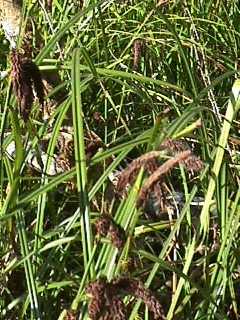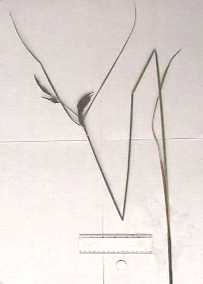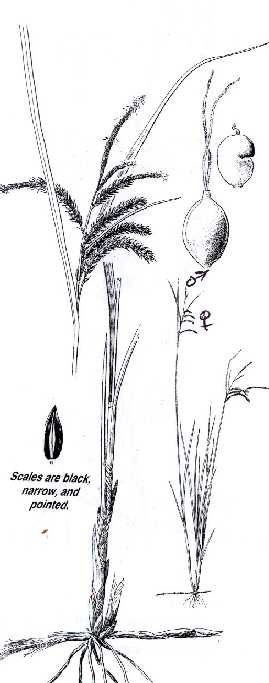


General Species Description
- Slough sedge is common in urban areas. It is typically 60-150 cm tall occuring in densely tufted creeping rhizomes. It has thick triangular stems. Upper leaves are shorter than the stems while lower leaves are reduced to sheathes. Sometimes it forms dense mono-specific stands in muddy areas of margins of marshes.
Leaves
- The leaves are coarse and stiff, about 3-7 mm wide, and have under-rolled margins. The upper leaves being shorter than the stems, contrast with the lowest leaves which are reduced to sheathes with purple-brown scales around the base that break into long fibers as they age.
Inflorescence/Flowers
- Four to eight cylindrical flower spikes are found at the tip of the stem subtended by two involucral bracts. Male and female flower spikes are separate, males above the females. The male flower spikes are 1-3 terminal, the female scales are narrow, pointed, dark brown or black with pale brown midribs and translucent margins. They are multiveined and longer than they peri. Blooms April through May.
Fruits
- The peri is elliptic, plump, thick walled 2.4 - 3.1 mm long shiny brown with obscure veins abruptly tapering to a short beak. Stigmas are two, lens shaped achene indented at the middle usually, filling the peri.
Habitat
- Prefers wet, shallowly inundated woods, meadows, roadside ditches, coastal swamps, marshes and river banks. In muddy areas it can be found in mono-specific stands . It is often found with Lysichiton americanum (skunk cabbage).
Range
- Occurs in all counties in Western Washinton and in Northwestern Oregon.
Similar Species
- Sometimes confused with Lyngby sedge (Carex lyngbyei). Best distinguished by keying comparisons of the scales and achenes. Both have long non sheathing involucral bracts subtending the lowest inflorescensce.
Ecological Value
- Sedge species provide singificant numbers of water dispersed seeds which are eaten by a variety of animals. Leaves are frequently used for nesting material and shelter.
Human Value
- The leaves of many sedges were used by Native Americans for thread in sewing garments and were used for basketry. Alaskan natives use the lower portion of some sedges (Carex aquatilis). The base 3-4 inches of the stem or culm, pinkish in color is eaten raw. It is reportedly succulent and sweet to the taste.
References
- Cooke, S.S., ed. 1997. A Field Guide to the Common Wetland Plants of Western Washington & Northwest Oregon. Seattle Audubon Society and Washington Native Plant Society. Seattle Audubon Society, Seattle, WA, 417 pp.
Heller, C.A. 1974. Wild Edible and Poisonous Plants of Alaska. Cooperative Extension Service , University of Alaska. Fairbanks, AK, 89 pp.
Hitchcock, C.L. and A. Cronquist. 1973. Flora of the Pacific Northwest. University of Washington Press, Seatle, WA, 730 pp.
This page was created by: Pete Catching, August 2000
Return to Northwest Oregon Wetland Plants Project